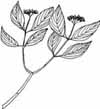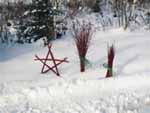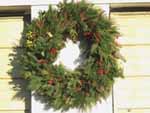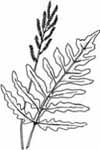Module 13: Non Timber Forest Products: Growing Opportunities
Lesson Three - The Excitement Of The Hunt:
Wildcrafting
 |
|
Red osier dogwood
|
The gathering of products from the land requires a unique set of skills that is known as wildcrafting. A wildcrafter hand-collects non-timber products from the wild, in a way that demands knowledge of both the ecology of the area and of the timing that affects the quality of the products. Certain products may be seasonal, or reach harvest condition only every few years.
Wildcrafters know that plants do not grow uniformly throughout the forest. Plant growth and abundance is dictated by the length of the growing season, climate, soil conditions, surrounding vegetation and age of the plants. A wildcrafter must be intimate with the land and with the passage of time.
 |
|
Red osier dogwood products
|
There are many examples of wildcrafting in Nova Scotia. Wildcrafting is usually done on a small scale that keeps one or two people busy for only part of the year. A few wildcrafters cultivate their products year-round, and supplement them with products gathered from the wild. For example, red osier dogwood (Cornus sericea) can be grown quite well in areas of abandoned field, and makes an attractive product on its own. When mixed with Canada holly and decorated with wild rose hips, dogwood can be used to create unique bundles, limited only by the imagination. A unique scent can be added to these decorative products by incorporating sweet fern (Comptonia peregrina) or hay-scented fern (Dennstaedtia punctilobula).
 |
|
Christmas wreath
|
Wildcrafting for Fun and Profit
"Imagination has everything to do with wildcrafting" indicates Lloyd Mapplebeck, who has enjoyed his hobby enough to turn it into a small business. As with most artistic endeavours, however, wildcrafting has never been a get-rich-quick enterprise. "It will never make you wealthy," states Lloyd. "If it pays you for your time, you've done well."
Lloyd and his daughter have been gathering plants and plant parts from their property for a number of years. They have also gotten permission from other landowners to collect from their woodlands, which allows them the freedom to gather a diverse array of plant materials during different times of the year. Fall is the busiest time of the year, as many shrubs begin to produce berries and lose their leaves, revealing colourful twigs.
 |
|
Sensitive fern
|
"The crafts we produce are very much in demand before Christmas," Lloyd says. The green tips of balsam fir, eastern white cedar and white pine contrast well with the twigs of red maple and red osier dogwood.
He has experimented making stars of red osier dogwood shoots tied with grass, and finds they sell well during the Christmas season. The stars are fairly easy to make (no bending of twigs involved) and can fetch $10 to $15 each, depending on size. Making wreaths of red osier dogwood is more time-consuming, although a wreath can sell for $20-$40.
Lloyd has also painted some of his products, and finds that gold is particularly effective around Christmas. He has applied gold paint to cattail heads, fronds of sensitive fern (which look like clusters of berries), pine cones and oak leaves. The gold effectively adds highlights to wreaths, for only the cost of a can of spray paint.
